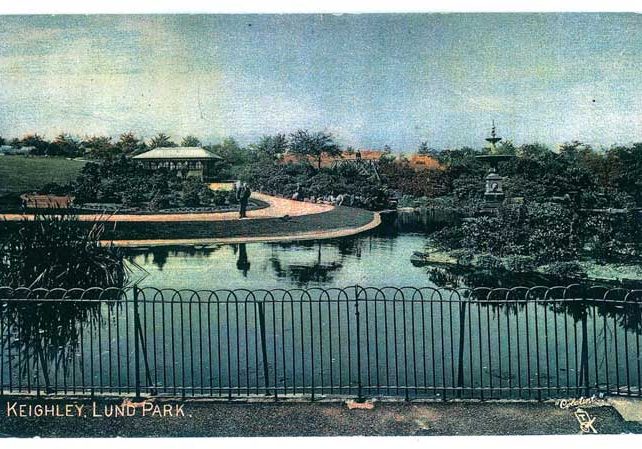
A pony for the parks | Lund Park, Keighley
by Northern Life
The early years of the twentieth century represented a palmy era in public parks. Their atmosphere of order and decorum is epitomised by a Keighley Parks Committee minute in 1905: “Resolved that it be an instruction to the Park Rangers to prohibit the erection of any tripod or other stand for the purpose of taking photographs in the Parks on Sundays.”
Lund Park, the gift of millowner James Lund in 1891, came into its own on Sundays, when bestdressed strollers could promenade its central avenue and admire its ‘magnificent’ fountain set in the middle of a pond.
In dusty and – at first glance- dry official files lie many small forgotten stories, none more appealing than that of the Lund Park pony, which was employed in what we might imagine as rather gentle harness, pulling a mowing machine and a roller, carting sand and peat (from Haworth Moor), coke and soil, sods and manure.
Our tale begins on a Friday morning in March, 1909, when Mr John Slater, the head gardener, “consulted Dr Carter with regard to the condition of the Pony”.
Veterinary surgeon Dr Carter opined “that the animal was suffering from Acute Rheumatism in its hind parts, and that the best plan would be to sell it to a farmer as it was still able to work but not every day.” Rather sadly, the records fail to dignify ‘it’ with a sex.
The Lund Park pony was 13 1⁄2 hands high, and had been working for Keighley Corporation for the past ten years. The Special Drainage Committee had bought it for £28 in 1899 ‘from J. Wilkinson, Stock Bridge,’ and had sold it to the Parks Committee for £18 in 1905 when its predecessor, ‘the old horse,’ had been auctioned off at Keighley fair.
But to return to 1909. Four days later when Dr Carter saw the pony again, its condition had deteriorated and he recommended its immediate slaughter, as it was in great pain. “This,” the Parks Committee was succinctly informed, “was done in the afternoon by David Hanson, Low Fold Farm, Long Lee.”
David Hanson advertised as the “only licensed horse-slaughterer in the Borough.”
In 1909 he was running a thoughtprovoking weekly notice in the Keighley News: “Wanted, 1,000 Worn-out Horses for foreign trade; also any number Dead Horses and Cows.”
Mercifully, he used the approved RSPCA killer. He allowed five shillings for the carcase of the Lund Park pony, which Mr Slater himself helped to load on to his cart.
There now arose the question of a successor. During the last six months of the previous year, the pony had cost £12 15s 8d (“Horseman’s Wages not included”) but since, by being hired out, it had helped to earn £8 14s 5d, this scarcely seems excessive.
Mr Slater recommended the purchase of another pony – he had seen one suitable at the Workhouse back in 1905 – but “apart from that he hadn’t one in view.” A simple advertisement was accordingly inserted in the Keighley News: “Wanted, Pony, about 14 hands, for parks. Send price and particulars to Borough Engineer, Town Hall.”
This produced an engaging crop of offers, and I leave unaltered the misspellings and grammatical errors of the letter-writers…

A postcard showing Lund Park in its sedate Edwardian heydays. Sadly, there are no known photographs of the park’s ponies.
Amos Crabtree of Haworth had an eightyear- old, 14-hand brown pony that he wanted £8 for.
James Feather of Park Lane (“wholesale tripe dresser, tallow and neats-foot-oil manufacturer”) asked £14 for his “honest sound & good worker.”
Ernest Hudson of Exley Head waxed descriptive over his dappled grey pony, “rising six years old,” price £25. It was “thick set standing on short legs with plenty of nice flatt bone, a good level walker essential for mowing espically in Parks.”
He could offer “no better proof of its qualities, willing quite and strong.”
“I have one whitch I will sell yow,” wrote Charles W Greenwood from Pecket Well, regarding his suspiciously under-priced £7 pony, “and I will gurrante her to work in any kind of Harness and verry Quiett to feed and yoke.”
Charles Greenwood was the only prospective seller to give his animal a sex, but even this was confusing: “If yow want to see him I will bring her to Keighley and let yow see her yoked in any gears yow want.”
Presumably the Parks Committee bought none of these, since the animal they selected cost £30. This too, for lack of information, we must call ‘it.’ The new pony proved as useful as its predecessor, but by 1914 – inevitably in the nature of things – the Parks Committee were controversially debating the cost of ‘horse-keep etc’ and questioning its feasibility.
Its veterinary charges averaged only 7s 6d a year, compared with £8 for repairs to cart and harness. Parks staff could “get the pony’s services at any time,” whereas if alternatively they were to hire one they would “have to wait – more or less – the convenience of carting agents.”
Unlike a hired animal, it was accustomed to working with a mowing machine. Most satisfyingly of all, it was fed largely by the fruits of its own labours: “More than half the pony’s food up to the present has consisted of hay and grass grown in Lund Park,” pleaded the man who worked with it, “no hay having been bought.”
Official files go silent at this point, suggesting that the Lund Park pony had to make way for progress.



